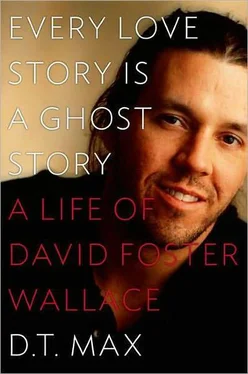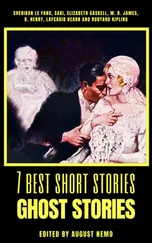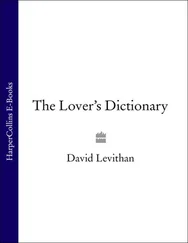Wallace moved out of Jaci’s house and in with Rich C. Part of the time sobriety left him so confused that he just lay on the couch and watched TV, but slowly he regained his footing and began to participate in the recovery group. He apologized to Heather Aronson for exaggerating his SAT scores (in fact it was to Forrest Ashby he had claimed they were perfect) and to Amy for his cruelty when she was younger. He asked his sponsor whether it might be possible to smoke pot if he dropped the drinking; after all, that had been his routine for almost a decade. “Why not just shoot heroin to avoid alcohol?” Rich C. replied, unconvinced. His sponsor taught him the Saint Francis prayer—“ Lord, make me a channel of thy peace ”—and he recited it often. A key part of the recovery program is to surrender to “a power higher than ourselves.” This was the hardest part for Wallace. He came from a family of skeptics. He claimed that his parents refused to let him or his sister go to church because it would contaminate the rigor of their thought; believers were little better than dupes. 17Yet Wallace was also a habitual top student; when he took a class he wanted to ace it. He invoked thinkers from Aristotle to Wittgenstein in an attempt to understand just what or whom he would be surrendering to. Rich C. sought to simplify the challenge: “All this step says is are you willing to make a decision.”
For the first time in his life, Wallace found his outsized intelligence a liability. To do well in recovery required modesty rather than brilliance. It was not easy for him to accept humbling adages like “Your best thinking got you here.” But then how smart could he be, the other program members would remind him at their meetings, if here he was in a room in the basement of a church with a dozen other people talking about how he couldn’t stop drinking? Wallace looked for other ways to excel. Some recovery fundamentalists insist that a true return to health means abstaining from all substances, including prescription drugs. So despite the reminders Wallace was getting to “Just do what’s in front of you to do,” as another of the program’s slogans goes, he quickly found himself with a new goal. To do without the Nardil, on which he’d relied for the past four years, would mark him as an exceptional recovery member. He hoped for an additional benefit — it was always possible that getting completely clean would jump-start his writing. His concentration was often poor, though whether it was the pot and alcohol or the Nardil and Xanax and other prescription drugs he sometimes took he did not know. When he bruited getting off the Nardil to his sponsor, Rich C. gave him an organization pamphlet emphasizing that meetings were not a substitute for a medical opinion. Wallace may have gone to talk to a psychiatrist (he noted on a medical history years later that he had consulted a doctor “only slightly if at all”), but whatever it was he heard or didn’t hear, he emerged ready to be completely drug-free.
He stopped taking the Nardil in mid-August and for a while seemed fine. Earlier in the summer he had moved to a cabin in the foothills to the west of the city, far from the campus and his past. He was determined to avoid his drinking and drug buddies, most of whom were still in Tucson. They worried about him and asked him if he was okay. “I’m lonely but I don’t want to come out of my house,” he told Jaci when she called him. “The effort is really hard for me.” From his kitchen he had a view of saguaro cactuses and sandy hills.
While he was in the cabin, a publisher sent him a galley of a novel by a writer he had barely heard of, one that impressed him deeply and seemed to embody all the literary qualities he had called for in his “Fictional Futures” essay. The book was Franzen’s The Twenty-Seventh City . Set in St. Louis, it mixed postmodernism and traditional storytelling and showed a familiarity with its chosen city that Wallace could only marvel at. It decanted a Pynchonesque conspiracy in media-mediated language; it was about the word and the world, realism for an era when there was no real. Wallace responded with enthusiasm to its editor, Jonathan Galassi:
I’m having a lot of trouble with my own stuff right now, and this book, a freaking first novel, seems so much more sophisticated than anything I could do plot-wise, so precocious in its marriage of theme and character and verisimilitude and phantasm, so simultaneously wild and controlled , that I found myself hugging criticisms of it to myself in unabashed self-defense (a subspecies of envy).
The novel was so good, Wallace concluded, that it “depressed” him. Later, he saw a copy of Franzen’s novel in an Arizona bookstore and was disappointed to see that the blurb he had given wasn’t used.
The semester started. Nardil leaves the body slowly, over weeks, and Wallace was by now feeling what it was like to be in an unmedicated depression, as he had not since his breakdown the summer after graduating from Amherst. His friends in recovery told him they were worried. He looked haggard, withdrawn, with slumped “barstool shoulders,” as Rich C. remembered it.
He began teaching a fiction writing class. He gave his students Updike’s “A&P” to read, and also the first paragraph of Flannery O’Connor’s “Good Country People,” to show the different ways you could describe a woman’s expression. He also threw in more innovative writing, such as Sorrentino’s Aberration of Starlight , the book he’d fallen in love with his first year in the MFA program, and a story by his friend Forrest Ashby. But within a few weeks he knew he was not going to make it through the semester. When Franzen asked where to write him — the two had struck up a correspondence after Wallace’s note to Galassi — he replied that by mid-October the chances of his still being in Tucson were “remote.” And in fact in late September, only weeks after the start of school and about a month after stopping the Nardil, he called his mother and asked her to come and get him. Amy Wallace called Heather Aronson, who with her sister Jaci went and looked after Wallace while they waited for Sally to arrive. They found their friend lying on his couch under blankets. His eyes were glued to the TV and he refused to drink or eat. A pot of weeks-old chili sat on the stove, and the computer that he had brought to Arizona was still in its boxes. He said he’d befriended a tarantula on his back porch.
A few days later, his mother came. The two rented a U-Haul, piled his stuff in the back, and took turns reading a Dean Koontz novel on the sixteen-hundred-mile trip back to Urbana. At twenty-six, Wallace was home for the fourth time after a breakdown. He was bitter and humiliated and felt as if his life was over. The same psychiatrist who had prescribed Nardil for him the first time put him back on the drug, but it did not have the same effect. For Wallace, life without any protection from depression was unlivable. His agony deepened. The Bad Thing was taking over again, eating him up. One night he took an overdose of Restoril, a sedative he’d been given for insomnia. His father found him the next morning, and an ambulance rushed him to the hospital, where he was put briefly on life support and had his stomach pumped.
Despite this near-tragedy, Wallace continued to write letters — the need to express himself in words never flagged. He wrote to Nadell on October 23 from the intensive care ward:
By now I expect maybe you’ve heard…I finally did something stupid last Wednesday simply because it hurt so bad I was willing to kill myself to have it end. A lot of the trouble has to do with writing, but none of it with having stuff to send you or publications or careers, nothing to do, really, with anything exterior to me.
Читать дальше












